Here are today’s most important updates from the realm of Science and Space.
Total Eclipse of the Moon & Breathtaking Images Taken from Space
Astronauts aboard the International Space Station have shared stunning photographs
of total lunar eclipse, offering a rare perspective of Earth’s shadow on the Moon taken from orbit. NASA astronaut Jonny Kim and Zena Cardman captured the images, documenting an astronomical event that’s difficult to observe from their unique vantage point. Zena Cardman detailed the crew’s creative efforts to photograph the eclipse, revealing unexpected challenges. “It’s a challenge to catch the moon up here – we don’t have any up-facing windows, so we can only see the moon for a few minutes between moonrise and moonset before it disappears above the ISS or below the horizon,” she shared.
The Universe Gives Birth and We Finally Have a Picture

A team of astronomers has detected for the first time a growing planet outside our solar system, embedded in a cleared gap of a multi-ringed disk of dust and gas. For years, astronomers have observed several dozen planet-forming disks of gas and dust surrounding young stars. Many of these disks display gaps in their rings, hinting at the possibility that they are being "plowed" by nearby nascent planets, or protoplanets, like lanes being cleared by a snowplow. Yet, only about three actual young growing protoplanets have been discovered to date, all in the cavities between a host star and the inner edge of its adjacent protoplanetary disk. Until this discovery, no protoplanets had been seen in the conspicuous disk gaps - which appear as dark rings.
NASA’s Rover Spots Strange ‘Turtle’ Shaped Rock on Mars

NASA's Perseverance rover has snapped an intriguing photo of a "turtle" appearing to poke its head out of its shell on the surface of Mars. The reptile-like structure is the latest in a long list of Martian rocks that look similar to living creatures or other Earth objects. The wandering, car-sized robot snapped the shot somewhere in the Jezero Crater — a 28-mile-wide (45 kilometers) depression where the rover touched down in 2021, which is thought to have previously contained a large lake. The photo was taken using the rover's Scanning Habitable Environments with Raman & Luminescence for Organics and Chemicals (SHERLOC) and Wide Angle Topographic Sensor for Operations and eNgineering (WATSON) instruments.
Eat Smart, Age Smart: 15-Year Study Reveals Foods That Shield the Brain and Heart

A major Swedish study shows that diet plays a key role in how chronic diseases accumulate with age. Healthy diets protect the brain and heart, while inflammatory diets raise risks. Researchers have investigated how four different diets affect the accumulation of chronic diseases in older adults. Three of the diets studied were healthy and focused on the intake of vegetables, fruit, whole grains, nuts, legumes, unsaturated fats and reduced intake of sweets, red meat, processed meat and butter/margarine. The fourth diet, however, was pro-inflammatory and focused on red and processed meat, refined grains and sweetened beverages, with lower intake of vegetables, tea and coffee.











